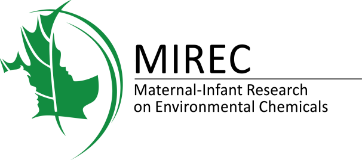
Prenatal exposure to phthalates, bisphenol A and perfluoroalkyl substances and cord blood levels of IgE, TSLP and IL-33.
Ashley-Martin J, Dodds L, Levy AR, Platt RW, Marshall JS, Arbuckle TE. Environmental Research. 2015 Jul;140:360-8. doi: 10.1016/j.envres.2015.04.010
The incidence of childhood allergic diseases (e.g., asthma, allergies, atopic dermatitis) has been increasing in recent decades, and this trend is not completely explained by established risk factors such as family history and smoking. Researchers have theorized that exposure to certain environmental chemicals, such as phthalates, bisphenol A (BPA), and perfluoroalkyl substances (PFASs), may increase the risk of childhood allergic disease. Phthalates and BPA are commonly found in household and consumer goods such as plastics, cosmetics, and food packaging. PFASs are used in the production of non-stick household and consumer products.
There is growing concern about prenatal exposure to environmental chemicals, as the fetal period is a critical window of immune system development and increased susceptibility to the potentially harmful effects of environmental exposures. Scientists have speculated that phthalates, BPA and PFASs may have adverse effects on the immune system. These effects may become evident in a changed immune system profile at birth. Disturbances to fetal immune system development, as shown by changes in the levels of certain immune system biomarkers, may increase the risk of future childhood allergic disease. [A biomarker is any measurable substance in an organism that can be used as an indicator of a particular disease state, environmental exposure, or some other physiological state]. These biomarkers include immunoglobulin E (or IgE, an antibody component of the immune system), and two cytokines known as thymic stromal lymphopoietin (TSLP) and interleukin-33 (IL-33), all of which play a central role in the cause(s) of childhood allergy and are detectable at birth. [Cytokines are small proteins that are important in cell signalling].
Although previous studies have looked at the role of IgE, TSLP, and IL-33 in the development of childhood allergic diseases, these biomarkers have not been adequately studied during the crucial period of fetal immune system development. In this study, researchers at Dalhousie University looked at the relationship between prenatal exposure to phthalates, BPA, and PFASs, and levels of IgE, TSLP, and IL-33 in umbilical cord blood. The researchers analyzed data collected in the MIREC Study. Of the 2,001 pregnant women in the MIREC cohort, 1,258 had a singleton, term birth and cord blood sample. The analysis was adjusted for other environmental contaminants correlated with those of interest and which could potentially influence the study results.
This study found that neither phthalates nor BPA in maternal urine nor PFASs in maternal blood were associated with elevated levels of either IL-33, TSLP or IgE in umbilical cord blood.
In this mainly urban Canadian population of pregnant women and their newborn infants, the researchers found that levels of phthalates, BPA, and PFASs in maternal urine and blood were not related to adverse effects on the immune system that appear as elevated levels of IgE, TSLP or IL-33 in umbilical cord blood. Future follow-up of these children as they get older will help to clarify whether the absence of effects of these chemicals on these immune system biomarkers continues into childhood.
MIREC Année all rights reserved - Privacy policy
Website by Riposte


